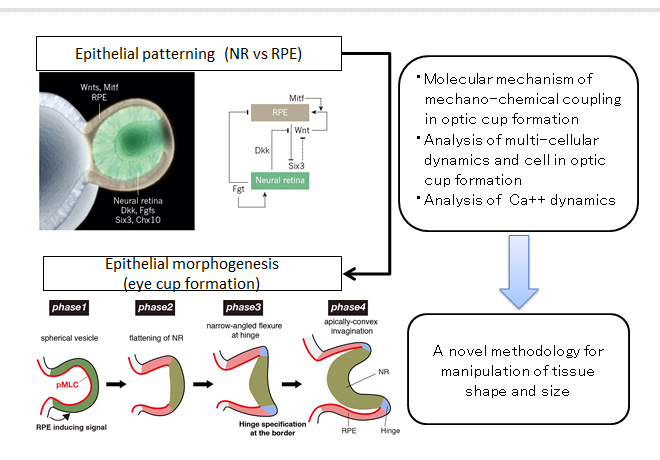|
HOME > Proposed research projects > 2014-2015: Proposed research projects 10
 2014-2015: Proposed research project 10A mechano-chemical coupling mechanism underlying optic cup morphogenesis in embryonic stem cell-derived tissue culture
Purpose of the Research ProjectGeneration of a functional organ with complex structures is a major challenge of stem cell biology. To manipulate differentiating cells and tissue shapes in vitro, it is important to understand chemical signals and biomechanical properties in a tissue formation. But, our knowledge of the principles by which organ architecture develops through complex collective cell behaviors is still limited. Our recent reports have demonstrated optic-cup morphogenesis can spontaneously occur in a three-dimensional stem cell culture even in the absence of external forces, and that mouse and human retinal progenitors have a latent intrinsic order to generate the optic cup structure. Based on this self-organized phenomenon, we proposed the "relaxation-expansion" model to interpret the tissue dynamics that enable the spontaneous invagination of the neural retina. While this model helps elucidate the intrinsic program for optic cup morphogenesis, there are still some unanswered questions regarding the relationship between tissue patterning by chemical signals and tissue-specific mechanical properties in this phenomenon. This research project aims to elucidate mechanisms of a mechano-chemical coupling system in the self-organized epithelial tissue morphogenesis. Content of the Research ProjectIn optic-cup self-organization, the determination of the neural retina compared (NR) with retinal pigment epithelium (RPE) seems to involve bistable state of Wnt signaling, which promotes differentiation of RPE. Indeed, canonical and non-canonical Wnt ligands were highly expressed in the border between NR and RPE (hinge region). Recently, we have found that spontaneous Calcium transients and rapid epithelial contraction were specifically observed in the hinge region during the optic cup morphogenesis. Based on these observations, we hypothesized that there are mechano-chemical coupling systems required for acquisition of region-specific mechanical properties during the neuroepithelial invagination. To test this, we plan to do two lines of researches: (1) Analysis of Wnt downstream signaling involved in a control of region-specific mechanical properties. (2) Artificial control of epithelial tissue shapes using 3-dimentional imaging and a local manipulation of signaling molecules involved in tissue growth and morphogenesis. Expected Research Achievements and Scientific SignificanceElucidation of the mechano-chemical coupling mechanism in optic cup morphogenesis can shed light on the complex processes of self-organized epithelial morphogenesis. Additionally, development of a novel methodology to manipulate complex multi-cellular behaviors leads to design the shape, size and functionality of organ in vitro. And, these outputs would contribute to a wide range of biomedical applications in future.
|








